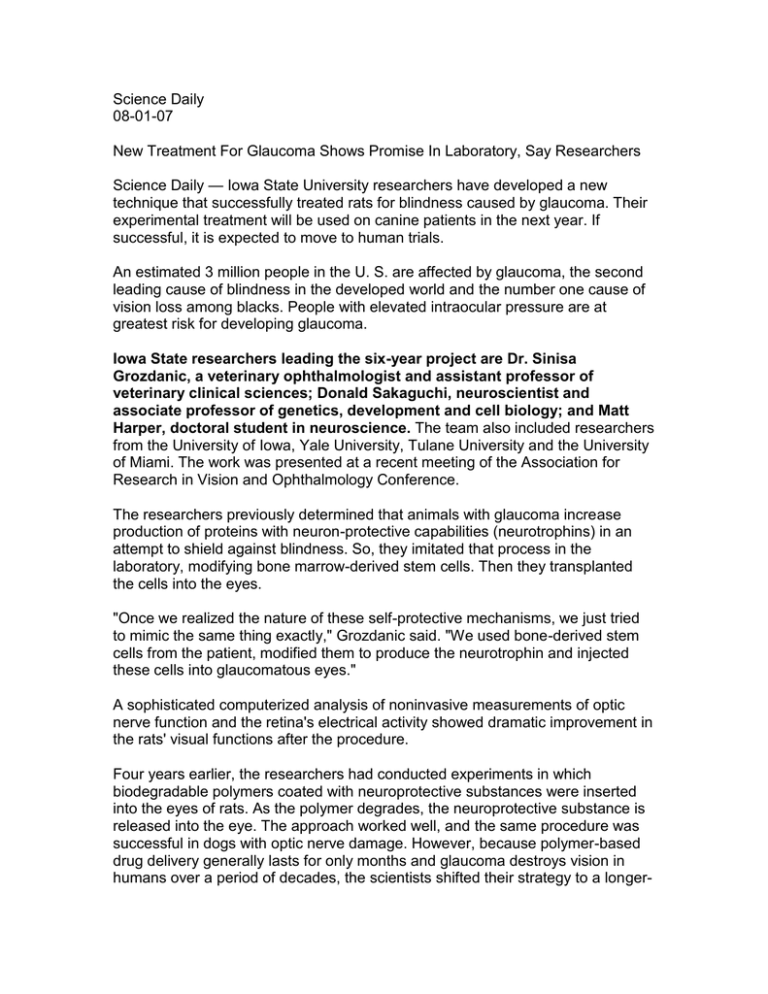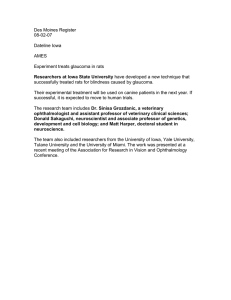Science Daily 08-01-07
advertisement

Science Daily 08-01-07 New Treatment For Glaucoma Shows Promise In Laboratory, Say Researchers Science Daily — Iowa State University researchers have developed a new technique that successfully treated rats for blindness caused by glaucoma. Their experimental treatment will be used on canine patients in the next year. If successful, it is expected to move to human trials. An estimated 3 million people in the U. S. are affected by glaucoma, the second leading cause of blindness in the developed world and the number one cause of vision loss among blacks. People with elevated intraocular pressure are at greatest risk for developing glaucoma. Iowa State researchers leading the six-year project are Dr. Sinisa Grozdanic, a veterinary ophthalmologist and assistant professor of veterinary clinical sciences; Donald Sakaguchi, neuroscientist and associate professor of genetics, development and cell biology; and Matt Harper, doctoral student in neuroscience. The team also included researchers from the University of Iowa, Yale University, Tulane University and the University of Miami. The work was presented at a recent meeting of the Association for Research in Vision and Ophthalmology Conference. The researchers previously determined that animals with glaucoma increase production of proteins with neuron-protective capabilities (neurotrophins) in an attempt to shield against blindness. So, they imitated that process in the laboratory, modifying bone marrow-derived stem cells. Then they transplanted the cells into the eyes. "Once we realized the nature of these self-protective mechanisms, we just tried to mimic the same thing exactly," Grozdanic said. "We used bone-derived stem cells from the patient, modified them to produce the neurotrophin and injected these cells into glaucomatous eyes." A sophisticated computerized analysis of noninvasive measurements of optic nerve function and the retina's electrical activity showed dramatic improvement in the rats' visual functions after the procedure. Four years earlier, the researchers had conducted experiments in which biodegradable polymers coated with neuroprotective substances were inserted into the eyes of rats. As the polymer degrades, the neuroprotective substance is released into the eye. The approach worked well, and the same procedure was successful in dogs with optic nerve damage. However, because polymer-based drug delivery generally lasts for only months and glaucoma destroys vision in humans over a period of decades, the scientists shifted their strategy to a longer- lasting approach. They genetically modified the bone marrow stem cells for transplantation so the delivery of the neuroprotective protein can be achieved for years. "One of the really unique aspects of this approach is that we can isolate these stem cells from the same individual being treated," Sakaguchi said. "It eliminates the ethical issues associated with embryonic stem cells, and the immunological problems of graft rejection." Grozdanic said the "results were phenomenal." So, the Iowa State team intends to use the technique on dogs as soon as possible. "Dogs suffer many of the same diseases people do and there's a lot of physiological similarity in their eyes and ours," Grozdanic said. "Four years ago, I was very skeptical that this would work," he said. "Now I see positive results. Hopefully in a few years, we'll be able to say it's working in humans." The cell biology work and the genetic modification were conducted by Sakaguchi and Harper, while Grozdanic developed techniques for evaluating the molecular changes in the animals. Researchers at the University of Miami provided genetic material for the modification while collaborators at Tulane assisted with culturing the bone marrow stem cells. A biodegradable polymer engineered with neuroprotective substances used in preliminary testing was developed by Erin Lavik at Yale University. Three faculty from the University of Iowa's Department of Ophthalmology and Visual Sciences - Dr. Randy Kardon, Dr. Young Kwon and Dr. Markus Kuehn - helped develop models of elevated eye pressure and assessing visual function. They also compared data from tissue from the rats and dogs to data from human donor tissue to help the team better understand molecular changes caused by glaucoma. Note: This story has been adapted from a news release issued by Iowa State University.


